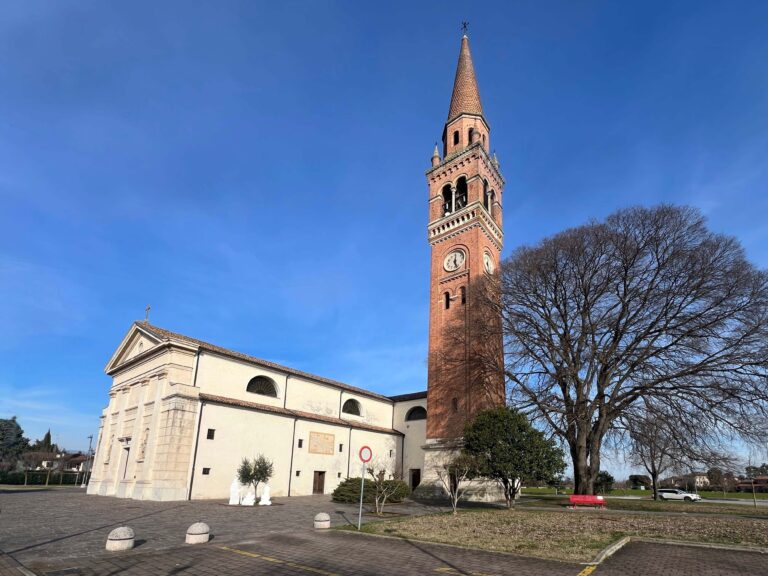ARTISTS’ ROADS
LE VIE DEGLI ARTISTI
watch the videos at the bottom of the page!
MARENO DI PIAVE
A Glimpse of Heaven, a Round Dance of Gazes
Conegliano was the birthplace not only of the great Giovan Battista Cima.
Perhaps it was in that very year, 1492, as the esteemed painter was sketching out his Holy Conversation, that Francesco Beccaruzzi was born.
Cima’s altarpiece was destined for the Church of Santa Maria dei Battuti in Conegliano, and one wonders how often young Francesco must have gazed up at that monumental work, so rich in Venetian atmosphere, crowded with saints before Mary and the Christ Child.
By the time he came of age and his talent unfolded, times had changed. By then, his gaze was fixed on the innovations in painting ushered in by Titian. Yet his attachment to that powerful composition would never fade.
A tireless observer, Francesco loved landscapes, but portraiture too, especially from the 1530s onwards.
He was a mature artist when, having just completed the Assumption of the Virgin for the cathedral of Valdobbiadene, he painted this work around 1545 for the parish church of Santi Pietro e Paolo in Mareno di Piave.
He employed a brilliant, masterfully orchestrated palette, creating visual, tactile, and even sonic impressions:
…morning breeze… fluttering wings… angelic choirs… keys chiming… whispered words…
It is an image to be listened to. In silence. And the movement animating it becomes a form of storytelling.
It is dawn. A cool paleness fills the landscape. From the flowered meadow in the foreground to the rolling hills, the turreted city bathed by the river, and the distant mountains painted soft blue by the moist air. This is a real, inhabited nature.
And then the sky parts, and hosts of cherubim, radiant with light, appear escorting Mary and the Child in glory.
Angels, like little pages, bear her regal crown and mantle.
Firmly grounded, six saints rise before us.
Their faces are vividly characterised, their garments rendered with care.
Grouped to either side of the composition, they appear to converse, two by two: John the Baptist speaks to Catherine of Alexandria. Paul to Sebastian. Roch gazes toward Peter, who, like a dancer mid-step, twists his body, ready for the solemn task Christ has entrusted to him.
The cord with the keys, Peter’s raised right arm, and the sword held by Paul form an invisible axis at the painting’s centre. It is a device the artist uses to guide the viewer’s gaze fluidly upward, from earth to heaven.
Opposite a broken column stands the tree trunk to which Sebastian is tied: on one side, the ruins of a world gone forever; on the other, a violently felled tree, ready to bear new fruit. This is the very meaning of martyrdom.
In this great painting in Mareno di Piave, Francesco Beccaruzzi distils a wealth of visual influences into an original synthesis, a testament to his broad figurative culture.
The six saints, arranged in groups of three to either side of the composition, clearly recall Cima da Conegliano’s Holy Conversation, so familiar to him.
The structure of the composition and the luminous figure of Saint Sebastian recall Titian.
Saint Paul echoes Palma Vecchio.
Saint Roch, the style of Savoldo.
The altarpiece today is without its original altar. It can be seen high above the organ, in a church that has since been enlarged.
But it ought to be experienced up close, imagined in the modest, graceful building for which it was painted, part of which still survives in the left-hand section of the nave, with its fine frescoes.
MORE EXPERIENCES!
I dodici inviati: immagini degli Apostoli:
- Guido Cadorin nella parrocchiale di Moriago
- La pieve di San Pietro di Feletto
- Carlo Donati e Giuseppe Modolo nell’arcipretale di Sernaglia
- L’oratorio di San Giorgio a Manzana, Vittorio Veneto
MULTIMEDIAL MAP: “ARTISTS’ ROADS – LE VIE DEGLI ARTISTI- EN”!

